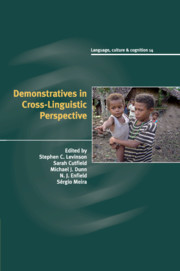
-
Select format
-
- Publisher:
- Cambridge University Press
- Publication date:
- July 2018
- July 2018
- ISBN:
- 9781108333818
- 9781108424288
- 9781108440028
- Dimensions:
- (228 x 152 mm)
- Weight & Pages:
- 0.78kg, 402 Pages
- Dimensions:
- (229 x 152 mm)
- Weight & Pages:
- 0.59kg, 404 Pages
You may already have access via personal or institutional login- Series:
- Language Culture and Cognition (14)
Book description
Demonstratives play a crucial role in the acquisition and use of language. Bringing together a team of leading scholars this detailed study, a first of its kind, explores meaning and use across fifteen typologically and geographically unrelated languages to find out what cross-linguistic comparisons and generalizations can be made, and how this might challenge current theory in linguistics, psychology, anthropology and philosophy. Using a shared experimental task, rounded out with studies of natural language use, specialists in each of the languages undertook extensive fieldwork for this comparative study of semantics and usage. An introduction summarizes the shared patterns and divergences in meaning and use that emerge.
Reviews
'Reporting on demonstratives in fifteen nearly all unrelated and 'exotic' languages, each language is studied with an identical, interactive elicitation technique, resulting in very detail language-specific descriptions as well as a typological sketch of the key parameters of variation. Even if readers already know that there is much more to this, that and the other than a proximal verus distal distinction, this book is a must.'
Johan van der Auwera - Universiteit Antwerpen
Contents
Metrics
Altmetric attention score
Full text views
Full text views help Loading metrics...
Loading metrics...
* Views captured on Cambridge Core between #date#. This data will be updated every 24 hours.
Usage data cannot currently be displayed.
Accessibility standard: Unknown
Why this information is here
This section outlines the accessibility features of this content - including support for screen readers, full keyboard navigation and high-contrast display options. This may not be relevant for you.
Accessibility Information
Accessibility compliance for the PDF of this book is currently unknown and may be updated in the future.


